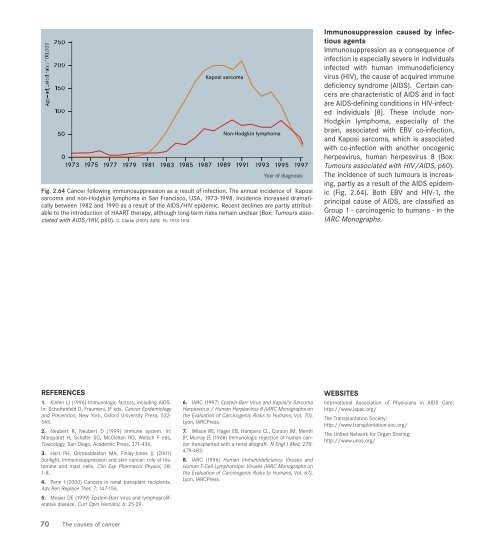world cancer report - iarc
world cancer report - iarc
world cancer report - iarc
You also want an ePaper? Increase the reach of your titles
YUMPU automatically turns print PDFs into web optimized ePapers that Google loves.
Fig. 2.64 Cancer following immunosuppression as a result of infection. The annual incidence of Kaposi<br />
sarcoma and non-Hodgkin lymphoma in San Francisco, USA, 1973-1998. Incidence increased dramatically<br />
between 1982 and 1990 as a result of the AIDS/HIV epidemic. Recent declines are partly attributable<br />
to the introduction of HAART therapy, although long-term risks remain unclear (Box: Tumours associated<br />
with AIDS/HIV, p60). C. Clarke (2001) AIDS, 15: 1913-1914<br />
REFERENCES<br />
1. Kinlen LJ (1996) Immunologic factors, including AIDS.<br />
In: Schottenfeld D, Fraumeni, JF eds, Cancer Epidemiology<br />
and Prevention, New York, Oxford University Press, 532-<br />
545.<br />
2. Neubert R, Neubert D (1999) Immune system. In:<br />
Marquardt H, Schafer SG, McClellan RO, Welsch F eds,<br />
Toxicology, San Diego, Academic Press, 371-436.<br />
3. Hart PH, Grimbaldeston MA, Finlay-Jones JJ (2001)<br />
Sunlight, immunosuppression and skin <strong>cancer</strong>: role of histamine<br />
and mast cells. Clin Exp Pharmacol Physiol, 28:<br />
1-8.<br />
4. Penn I (2000) Cancers in renal transplant recipients.<br />
Adv Ren Replace Ther, 7: 147-156.<br />
5. Mosier DE (1999) Epstein-Barr virus and lymphoproliferative<br />
disease. Curr Opin Hematol, 6: 25-29.<br />
70 The causes of <strong>cancer</strong><br />
6. IARC (1997) Epstein-Barr Virus and Kaposi's Sarcoma<br />
Herpesvirus / Human Herpesvirus 8 (IARC Monographs on<br />
the Evaluation of Carcinogenic Risks to Humans, Vol. 70),<br />
Lyon, IARCPress.<br />
7. Wilson RE, Hager EB, Hampers CL, Corson JM, Merrill<br />
JP, Murray JE (1968) Immunologic rejection of human <strong>cancer</strong><br />
transplanted with a renal allograft. N Engl J Med, 278:<br />
479-483.<br />
8. IARC (1996) Human Immunodeficiency Viruses and<br />
Human T-Cell Lymphotropic Viruses (IARC Monographs on<br />
the Evaluation of Carcinogenic Risks to Humans, Vol. 67),<br />
Lyon, IARCPress.<br />
Immunosuppression caused by infectious<br />
agents<br />
Immunosuppression as a consequence of<br />
infection is especially severe in individuals<br />
infected with human immunodeficiency<br />
virus (HIV), the cause of acquired immune<br />
deficiency syndrome (AIDS). Certain <strong>cancer</strong>s<br />
are characteristic of AIDS and in fact<br />
are AIDS-defining conditions in HIV-infected<br />
individuals [8]. These include non-<br />
Hodgkin lymphoma, especially of the<br />
brain, associated with EBV co-infection,<br />
and Kaposi sarcoma, which is associated<br />
with co-infection with another oncogenic<br />
herpesvirus, human herpesvirus 8 (Box:<br />
Tumours associated with HIV/AIDS, p60).<br />
The incidence of such tumours is increasing,<br />
partly as a result of the AIDS epidemic<br />
(Fig. 2.64). Both EBV and HIV-1, the<br />
principal cause of AIDS, are classified as<br />
Group 1 - carcinogenic to humans - in the<br />
IARC Monographs.<br />
WEBSITES<br />
International Association of Physicians in AIDS Care:<br />
http://www.iapac.org/<br />
The Transplantation Society:<br />
http://www.transplantation-soc.org/<br />
The United Network for Organ Sharing:<br />
http://www.unos.org/

















